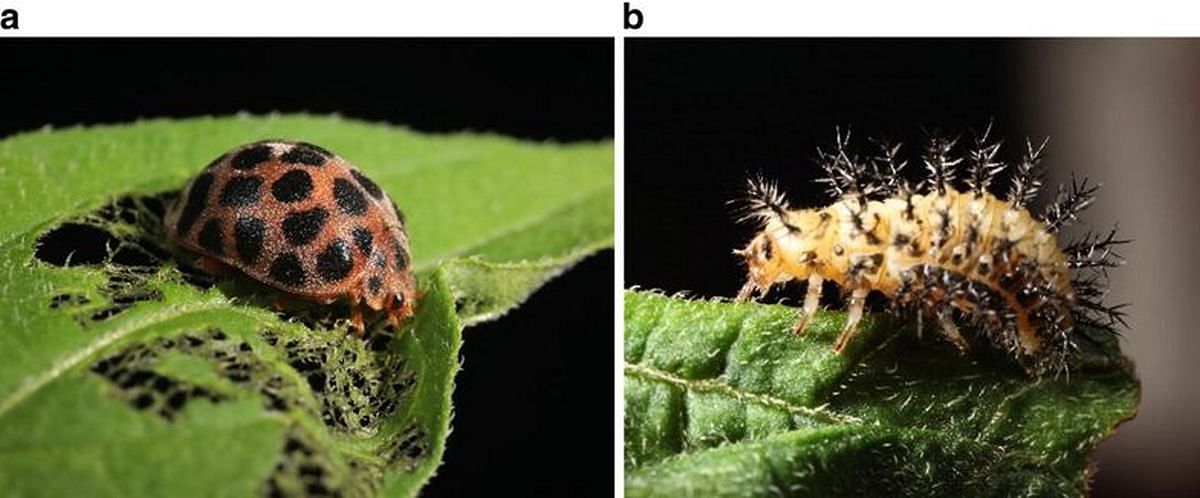Scientific description of the Ladybird Beetles (2020)
The authors of this content are Jürgen Kroschel, Norma Mujica, Joshua Okonya, Andrei Alyokhin
Henosepilachna vigintioctomaculata (Motschulsky),
Henosepilachna vigintioctopunctata (F.) (Coleoptera: Chrysomelidae)
Distribution
Henosepilachna vigintioctomaculata and H. vigintioctopunctata are two related and morphologically similar species of phytophagous lady bird beetles that share a common name of a potato ladybird, hadda beetle, or 28-spotted lady bird beetle (image below). H. vigintioctomaculata is common in temperate areas of Asia, including China, Japan, Korea, and Russia.
The ranges of both species overlap, particularly in China. However, H. vigintioctopunctata prefers warmer climates and is widely distributed in Southeast and South Asia, including Pakistan, and has been introduced to Australia, New Zealand, several Pacific islands, and South America (Katakura 1980; Naz et al. 2012; Xu et al. 2013).
Henosepilachna vigintioctopunctata (F.) (Coleoptera: Chrysomelidae)
Distribution
Henosepilachna vigintioctomaculata and H. vigintioctopunctata are two related and morphologically similar species of phytophagous lady bird beetles that share a common name of a potato ladybird, hadda beetle, or 28-spotted lady bird beetle (image below). H. vigintioctomaculata is common in temperate areas of Asia, including China, Japan, Korea, and Russia.
The ranges of both species overlap, particularly in China. However, H. vigintioctopunctata prefers warmer climates and is widely distributed in Southeast and South Asia, including Pakistan, and has been introduced to Australia, New Zealand, several Pacific islands, and South America (Katakura 1980; Naz et al. 2012; Xu et al. 2013).

28-spotted ladybird beetle, Henosepilachna vigintioctomaculata, adult (a) and larva (b). (Courtesy: Yulin Gao, Institute of Plant Protection, Chinese Academy of Agricultural Sciences)
Host range
Potato ladybirds are polyphagous species feeding on a variety of plant species. However, most severe damage is usually reported for Solanaceae’s crops, including potato (Xu et al. 2013).
Potato ladybirds are polyphagous species feeding on a variety of plant species. However, most severe damage is usually reported for Solanaceae’s crops, including potato (Xu et al. 2013).
Symptoms of infestation
Both adults and larvae feed on potato leaves, causing their complete defoliation and eventual death in cases of severe infestation. Feeding by larvae usually starts on the lower sides of infested leaves. Lower epidermis and mesophyll get consumed, while higher epidermis and large veins remain relatively intact (Jackson 2016; Xu et al. 2013).
Affected leaves eventually dry up and die. Furthermore, feeding damage may facilitate infections by gray mold, Botrytis cinerea Pers. ex Fr. (Yao et al. 1992).
Both adults and larvae feed on potato leaves, causing their complete defoliation and eventual death in cases of severe infestation. Feeding by larvae usually starts on the lower sides of infested leaves. Lower epidermis and mesophyll get consumed, while higher epidermis and large veins remain relatively intact (Jackson 2016; Xu et al. 2013).
Affected leaves eventually dry up and die. Furthermore, feeding damage may facilitate infections by gray mold, Botrytis cinerea Pers. ex Fr. (Yao et al. 1992).
Methods of prevention and control
- Monitoring pest populations.
All life stages of potato ladybirds are rather conspicuous, in large part due to their aposematic coloration. Therefore, they can be relatively easily detected by visual observations. Eggs are usually laid in clusters of 20–30 on lower leaf surfaces, thus requiring that scouted leaves are turned upside-down. - Biological control.
The parasitic wasp Pediobius foveolatus (Crawford) can parasitize 50–60% of field potato ladybird populations. In some cases, this reduces damage to economically acceptable levels, and no further control is necessary (Puttarudriah and Krishnamurti 1954; Venkatesha 2006).
However, such high parasitism rates should not be taken for granted, and a careful monitoring of ladybird populations is required. - Crop management.
Removing and destroying crop residue after harvest deprive resident potato ladybirds of food, thus dramatically enhancing their mortality (Jackson 2016; Xu et al. 2013). - Physical control.
Manual destruction of potato ladybird beetles is recommended for small potato plots (Xu et al. 2013). Success of this approach is facilitated by the tendency of ladybird adults to aggregate at overwintering sites outside of potato fields. Adult ladybird beetles are strongly phototactic (Zhou et al. 2015).
Therefore, light traps can be used to reduce their numbers. However, feasibility of this approach remains to be investigated. Also, light traps attract a wide variety of insects, including beneficial species (Zhou et al. 2015). - Biological insecticides.
Some botanical products, such as azadirachtin, have a good efficacy for ladybird management (Ghosh and Chakraborty 2012; Jeyasankar et al. 2014). Also, the entomopathogenic fungi Beauveria bassiana and Metarrhizium anisopliae (Vishwakarma et al. 2011) and Bacillus thuringiensis (Song et al. 2008) are used. - Chemical Control.
Potato ladybird beetles can be easily killed by common broad-spectrum insecticides, which remains unfortunately the most common approach to controlling these pests (Xu et al. 2013).
